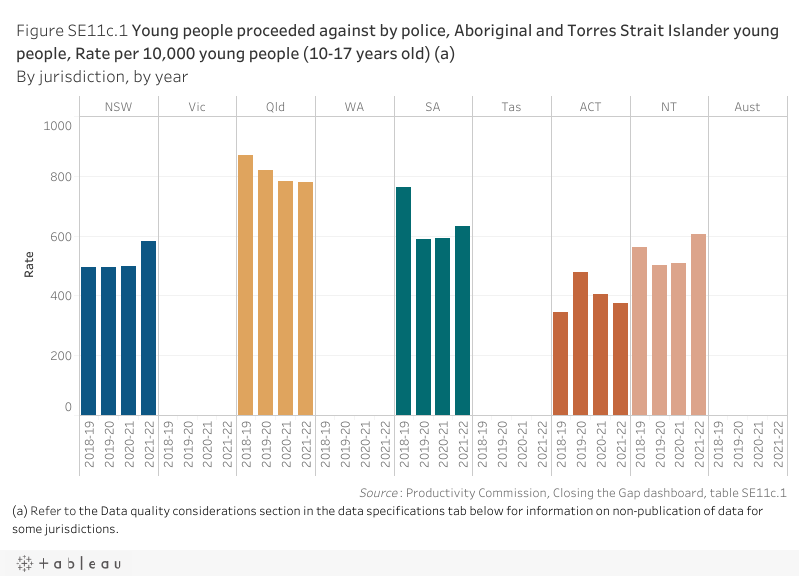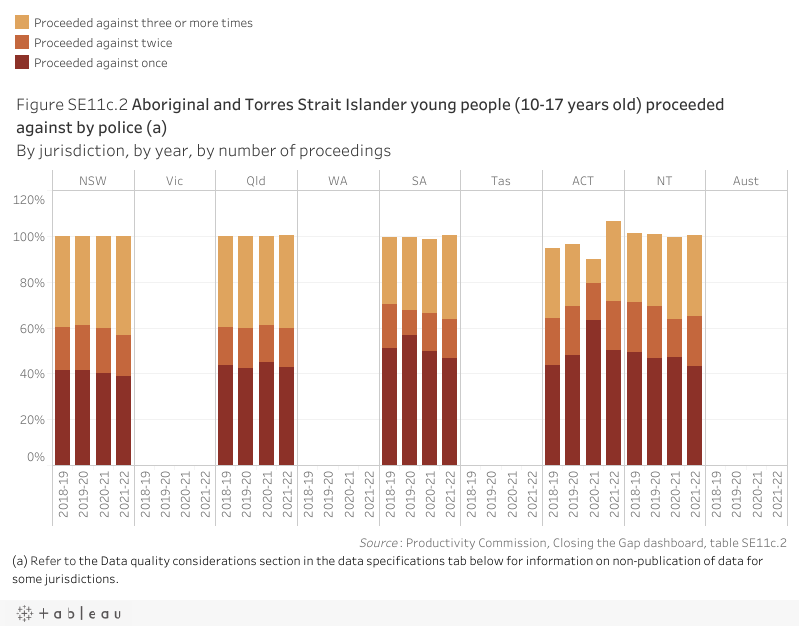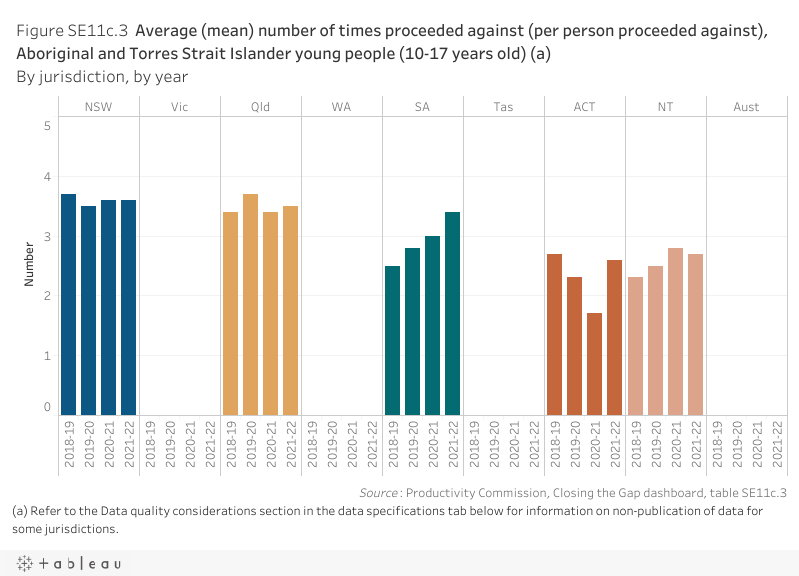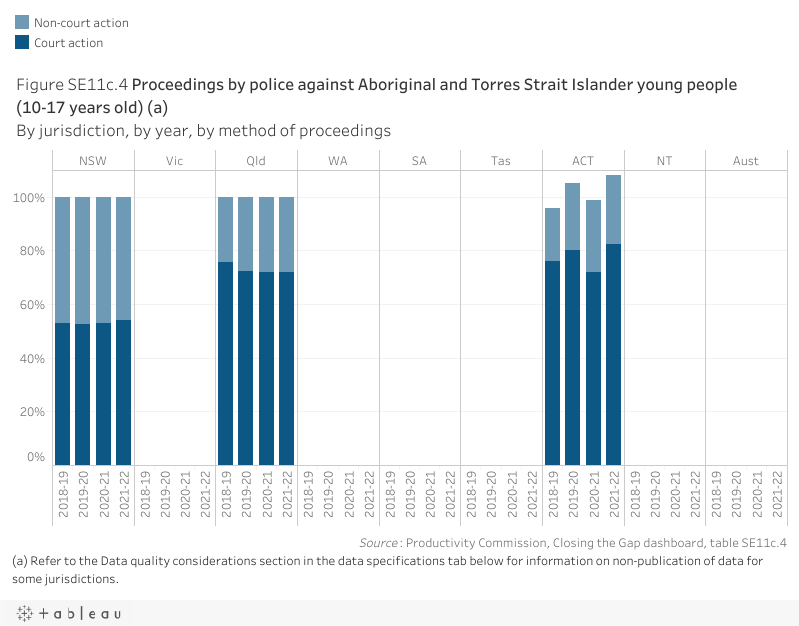Driver
Proportion of young alleged offenders (10–17 years) involved in police proceedings
Including charges and summons, cautions, diversions
Data tables appear under figures
Measure 1
Rate of young people proceeded against by police
In 2021-22, across the five jurisdictions with available data, the rate of Aboriginal and Torres Strait Islander young people proceeded against by police ranged from 374.4 to 779.6 per 10,000. Since the 2018‑19 baseline year, the direction of change for these rates has differed across jurisdictions (figure SE11c.1).

Measure 2
Proportion of young people proceeded against by police by number of times proceeded against
In 2021-22, across the five jurisdictions with available data, for Aboriginal and Torres Strait Islander young people proceeded against by police, the proportion proceeded against once ranged from 38.8% to 50.0% (by comparison, between 16.8% to 21.7% were proceeded against twice, and between 34.8% and 43.4% were proceeded against three or more times). For all five jurisdictions, the proportions of young people proceeded against more than once in 2021‑22 are higher than the previous year (figure SE11c.2).

Measure 3
Average (mean) number of times young people are proceeded against by police
In 2021-22, across the five jurisdictions with available data, the average (mean) number of times an Aboriginal and Torres Strait Islander young person was proceeded against by police ranged from 2.6 to 3.6 times. Since the 2018‑19 baseline year, the direction of change for this number has fluctuated across jurisdictions (figure SE11c.3).

Measure 4
Proportion of police proceedings against young people by method of proceeding
In 2021-22, across the three jurisdictions with available data, for Aboriginal and Torres Strait Islander young people proceeded against by police, the proportion proceeded against with non-court actions ranged from 25.7% to 46.1% (with the remaining 53.9% to 82.4% proceeded against with court actions). Since the 2018‑19 baseline year, the proportion with non‑court action has fluctuated across jurisdictions (figure SE11c.4).

Indicator data specifications
Related outcome: | Aboriginal and Torres Strait Islander young people are not overrepresented in the criminal justice system. |
|---|---|
Related target: | By 2031, reduce the rate of Aboriginal and Torres Strait Islander young people (10–17 years) in detention by at least 30%. |
Indicator: | Proportion of young alleged offenders (10–17 years) involved in police proceedings including charges and summons, cautions, diversions. |
Measure: | There are four measures for this indicator. Measure 1 is the rate of young people proceeded against by police, defined as: Numerator – number of Aboriginal and Torres Strait Islander people aged 10–17 years proceeded against by police Denominator – number of Aboriginal and Torres Strait Islander people aged 10–17 years and is presented as a rate per 10, 000 young people. Measure 2 is the proportion of young people proceeded against by police, by the number of times proceeded against, defined as: Numerator – number of Aboriginal and Torres Strait Islander people aged 10–17 years proceeded against by police, by times proceeded against (one, two, or three or more times) Denominator – number of Aboriginal and Torres Strait Islander people aged 10–17 years proceeded against by police and is presented as a percentage. Measure 3 is the average (mean) number of times young people are proceeded against by police, defined as: Numerator – number of police proceedings against Aboriginal and Torres Strait Islander people aged 10–17 years Denominator – number of Aboriginal and Torres Strait Islander people aged 10–17 years proceeded against by police and is presented as a number. Measure 4 is the proportion of police proceedings against young people by method of proceeding, defined as: Numerator – number of police proceedings against Aboriginal and Torres Strait Islander people aged 10–17 years, by method of proceeding (court/non‑court action) Denominator – number of police proceedings against Aboriginal and Torres Strait Islander people aged 10–17 years and is presented as a percentage. Contextual information will be reported on the proportion of offenders for whom Indigenous status is reported as unknown/not stated. |
Indicator established: | National Agreement on Closing the Gap July 2020 |
Latest dashboard update for the indicator: | 15 June 2023 |
Indicator type: | Driver |
Interpretation of change: | Measure 1: a low or decreasing rate is desirable. Measure 2: a low or decreasing proportion is desirable. Measure 3: a low or decreasing average (mean) number is desirable. Measure 4: a low or decreasing proportion is desirable. |
Data source(s): | (Measures 2, 3, 4 and numerator for Measure 1) Name: Recorded Crime – Offenders Frequency: Annual Documentation (links): https://www.abs.gov.au/statistics/people/crime-and-justice/recorded-crime-offenders (Denominator for Measure 1) Name: Estimates and projections for Aboriginal and Torres Strait Islander population Frequency: Annual (data revised on a five‑yearly basis) |
Data provider: | (Measure 2, 3, 4 and numerator for Measure 1) Provider name: Australian Bureau of Statistics (ABS) Provider area: National Centre for Crime and Justice Statistics (Denominator for Measure 1) Provider name: Australian Bureau of Statistics Provider area: Demography |
Baseline year: | 2018-19 |
Latest reporting period: | 2021-22 |
Disaggregations: | State and territory and Australia, by Indigenous status. |
Computation: | Measure 1: Numerator divided by Denominator multiplied by 10, 000. Measure 2: Numerator divided by Denominator multiplied by 100. Measure 3: Numerator divided by Denominator. Measure 4: Numerator divided by Denominator multiplied by 100. Counting rules ‘People proceeded against by police’ represents a person aged 10 years or over who is proceeded against and recorded by police for one or more criminal offences. An offender is only counted once during the reference period irrespective of the number of offences committed or the number of separate occasions that police proceeded against that offender. ‘Police proceedings’ represent a count for each separate occasion within the 12‑month reference period that police initiate a legal action against an alleged offender. The number of young people proceeded against and the total number of proceedings cannot be used to derive the average (mean) times proceeded against for offenders. The average (mean) times proceeded against measure is a specific count at the offender level on how many occasions ‘Aboriginal and Torres Strait Islander’ and ‘non-Indigenous’ young offenders came into contact with police during the reference year and this does not match the data held for the count of proceedings for ‘Aboriginal and Torres Strait Islander’ and ‘non-Indigenous’ young offenders. These do not align for a number of reasons; for example a person may:
Court actions by police include the following ABS codes:
Non-court actions by police include the following ABS codes:
Exclusions (all measures): People/proceedings with an unknown or not stated Indigenous status (these are reported separately) Offenders with a penalty notice as their principal method of proceeding. |
Data quality considerations: | Data values have been randomly adjusted using perturbation to avoid the release of confidential data. Discrepancies may occur between sums of the component items and totals. The quality of Aboriginal and Torres Strait Islander identification varies across jurisdictions. Data are only available by Indigenous status for New South Wales, Queensland, South Australia, the Australian Capital Territory and the Northern Territory. Based on an ABS assessment, Indigenous status data for other states are not of sufficient quality and/or do not meet ABS standards for national reporting. Due to data quality issues, data are not available for method of police proceeding (i.e. court/non-court proceedings) for South Australia and the Northern Territory. Caution should be used when comparing Indigenous status data across states and territories or time periods, due to variations in the proportion of offenders with unknown Indigenous status. |
Future reporting: | Additional disaggregations required for future reporting:
|
